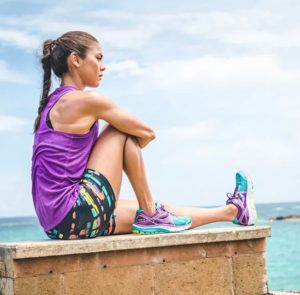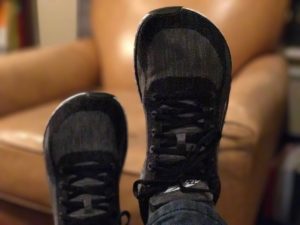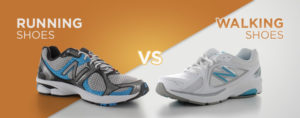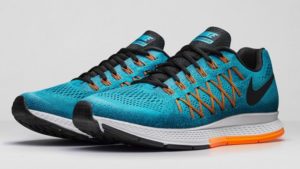The most comfortable walking shoes – features that will make your feet happy.

Let’s face it… What everyone’s looking for, initially, is comfort. You want a walking shoe that fits comfortably, right out of the box.
But not so fast.
If you choose a walking shoe that feels like a slipper, you might be sorry once you get out on the road or the trail.
The secret to a good walking shoe is the delicate balance between comfort and all-around support.
Fitting into a walking shoe is not the same as fitting into a tennis shoe or a cross-trainer. When you’re playing court sports or doing CrossFit, you have a lot of lateral motion to contend with. Which means you need the shoe to be snug and laterally stable.
When you’re walking, the motion is one-directional. Forward only. No side to side. You don’t have to worry about the lateral motion you encounter in many other sports.
For my feet, which are wide in the toe box but not big in volume overall, that means I have to start with tennis shoes that seem too tight. A couple of games of tennis, with plenty of lunging, sprinting, cutting and back peddling, will loosen them up. But I wouldn’t recommend that approach for walking shoes.

The problem is, many shoes that initially feel comfortable are simply too big for you. That’s the most common mistake people make when buying athletic shoes of any kind. We buy them too big. Then we crank down the laces and wear extra-thick socks, but that’s not so fun on a warm summer day. Better to find the right fit the first time.
Here are the main considerations, and some tips on finding comfortable walking shoes that’ll fit your particular foot.
Can I use running shoes for walking?
At most of the big chain stores like Dick’s Sporting Goods or Foot Locker, customers who come in for walking shoes are routinely pushed toward running shoes. Especially the ones that have thick, built-up soles.
The argument is, running is basically the same. We disagree, but It depends on what type of walking you’re doing.

I have a pair of running shoes, Hoka, Escalantes, that are exceptionally comfortable. I wear them for walks around the neighborhood, and for everyday wear, but the minute I get off the smooth pavement they seem inadequate.
I’d much rather wear my Keen light hikers. Sure, they’re heavier than any running shoe, but that’s not really an issue for walking. I’d sacrifice a little weight for more stability and support, any day.

New Balance has been doing extensive research on walking shoes for more than 30 years. They make some of the most comfortable walking shoes on the market.
Here’s what they have to say about the difference between running shoes and walking shoes: You need the right tool for the job.
At first glance, walking and running seem very similar. But when you look closely at the demands they place on your feet and your footwear, the two are really quite different.
As you walk, the body’s weight is distributed more evenly on the foot than when you run. When walking, your weight rolls from the heel, through the ball and continues to the toe in one foot after the other. This gentler, rocking-chair like motion requires your feet to absorb the shock of only 1-2x your body weight with each step. And, during walking there are points where both feet are firmly on the ground, dividing weight.
Running, on the other hand, requires the support of at least 2-3x your body weight and each stride has moments with neither foot on the ground. With each step, the outer heel absorbs most of the impact before distributing weight through the foot in an S motion through toe-off. So what’s this mean to your shoes? Basically, it’s the old axiom of having the right tool for the job.
See our complete BUYER’S GUIDE.
Walking shoes are designed with the specific body mechanics and strike path of walking in mind. They are constructed to be more flexible through the ball of the foot to allow a greater range of motion through the roll of the forefoot. They also have greater arch support to protect where the force is heaviest on the foot.
Running shoes, in contrast, have more cushioning in the heel–the point of impact–and less protection through the ball of the foot. Your feet also generate a lot of heat when running, so running shoes also are made with a higher amount of mesh to keep feet cool.
Picking the proper shoes can eliminate discomfort, prevent injury and encourage you to maintain an active lifestyle.
Once you’ve ordered a few pairs of shoes online, test them out inside the house. Wear the socks you normally exercise in and give the shoes a good, thorough walk. Go up and down the stairs a few times, and leave them on for at least 30 minutes.
The shoes should be comfortable as soon as you put them on. If the shoes are tight, do not expect them to stretch out.
The heel ought to fit snugly, not slip up out of the shoe. Since feet swell during the day, shop for shoes in the afternoon or after a long walk. To prevent painful blisters, calluses, and to avoid foot disorders like bunions and hammertoes, check for enough room on the sides of your feet, above your toes, and about a half-inch between the end of your longest toe and the shoe.
When picking a new pair of walking shoes, be sure to consider your arch type. You can determine this by bringing an old shoe to the store with you, or by dampening your foot and placing it on a piece of paper. What does your footprint look like?
If you don’t see much of a footprint, you have a high arch. Feet with high arches may be prone to stress because of the lack of natural shock absorption. If it is a wide, full-foot footprint, your feet are flat.
Seek shoes with cushioning to alleviate this problem. If your feet are flat, they may not support your body well, leading to muscle and joint stress in your feet and knees. Walking shoes that are more structured will give you stability. Look for shoes with medial (inside) support to limit over-pronation and support your feet.
See our list of men’s Walking Shoes.
The most comfortable walking shoes match your arch type

The intricate alignment of bones, muscles, ligaments, and tendons in your feet forms side-to-side (metatarsal) and lengthwise (longitudinal) arches. As you walk, these springy, flexible arches help distribute your body weight evenly across your feet. Your arches play an important role in how you adapt to various surfaces as you walk.
Choose comfortable walking shoes that accommodate your arch type. Generally speaking, your feet fall into one of three categories:
- Neutral-arched feet. Your feet aren’t overly arched nor are they overly flat. Look for shoes with firm midsoles, straight to semi-curved lasts — last refers to the shape of the sole and the footprint around which the shoe is built — and moderate rear-foot stability.
- Low-arched or flat feet. Low arches or flat feet may contribute to muscle stress and joint problems in some individuals, though there is not a direct correlation. If you have significantly flat feet, you may benefit from a walking shoe with a straight last and motion control to help stabilize your feet.
- High-arched feet. High arches may contribute to excessive strain on joints and muscles, as your feet may not absorb shock as well, especially if you perform a lot of impact or jumping activities. Look for cushioning to compensate for your lack of natural shock absorption. A curved last also may help in some cases.
Not sure about your foot type? Dip your foot in water and step on a piece of cardboard. Examine your footprint. If you can see most of your footprint, you probably have low arches. If you see very little of your footprint, you likely have high arches. Most important of all, however, is comfort. Multiple studies have shown that there is no one “best shoe” for a particular foot type, and comfort and proper fit should be the main criteria you use.

According to the Mayo Clinic, these are the basic features of the most comfortable walking shoes that you should be looking for:
- Achilles tendon protector. Reduces stress on the Achilles tendon by locking the shoe around the heel.
- Heel collar. Cushions the ankle and ensures a proper fit.
- Upper. Holds the shoe on your foot and is usually made of leather, mesh or synthetic material. Mesh allows better ventilation and is lighter weight.
- Insole. Cushions and supports your foot and arch. Removable insoles can be laundered or taken out to dry between walking sessions. However, the stock insoles that come in just about any shoe are almost worthless. (hyperlink to another post here)
- Gel, foam or air midsole. All of these materials cushion and reduce impact when your foot strikes the ground.
- Outsole. Makes contact with the ground. Grooves and treads can help maintain traction.
- Toe box. It provides space for the toes. A roomy and round toe box helps prevent calluses.

Look for good shoe construction
Some basic principles of a good shoe include a cushioned heel, firm sole that doesn’t easily twist or bend, and flexibility at the proper area depending on the type of shoe. Soft breathable material for the upper of the shoe makes it more comfortable to wear for a longer period of time and less likely to cause rubbing or skin irritation. The upper of the shoe should allow adjustment (laces, straps, etc.) to comfortably hold the foot in place while you’re walking.
There should be some arch support in the shoe. Many shoes can be made to fit better simply by removing the flimsy factory insert and replacing it with a high-quality off-the-shelf insole. Custom orthotics are rarely necessary and should be prescribed by your doctor for specific foot disorders.
Following these simple steps will help minimize your risk of shoe problems and foot problems. Don’t believe the myth that fashionable shoes have to be uncomfortable. There are many stylish shoes out there that feel good too. If you have certain foot or ankle problems, then talk to your orthopedic foot and ankle doctor. Don’t sacrifice comfort and safety for fashion. Your feet will thank you in the long run, short run, and even just walking around.
Cushioning vs style. Those are the two things that most women consider when buying shoes. Cushioning feels good but doesn’t provide the stability you need. A lack of stability causes the majority of weight-bearing injuries such as stress fractures.
